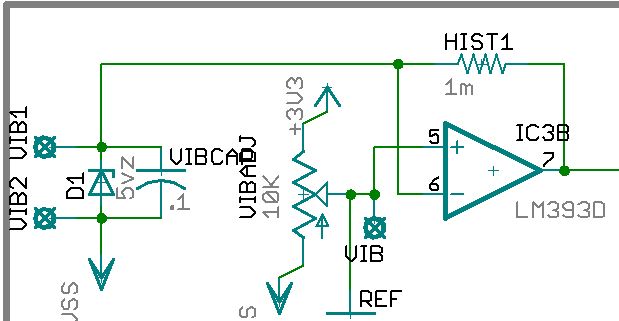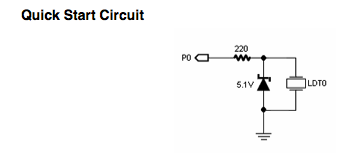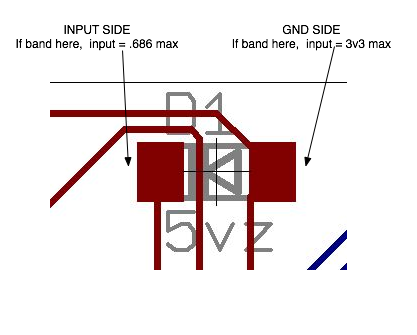Zener mystery.
I took the similar circuit shown on the Parallax Piwzo Vibra Tab pdf shown below, I only added a cap so that I could adjust the response if desired.
Shown is my exact board design, but there is a strange thing. Without using the Vbra tap, just applying a voltage from 0 - 3v3 from a Prop DAC (10k, .01cap), the voltage after the 10k which feeds the - input of the comparator is never higher that .686v, even if the input is 3v3. So I assumed the 5v1 zener was in backwards, and reversed it, then I can apply whatever voltage I want up to 3v3.
I checked the package to verify cathode is the marked side, I checked the symbol too, these are stock Eagle library parts.
What am I missing with this? Surely the zener should allow up to 5.1v to pass through?
I am questioning if the current limiting resistor off the DAC is causing the result.
search.digikey.com/scripts/DkSearch/dksus.dll?lang=en&site=US&keywords=FLZ5V1CCT-ND&x=0&y=0
Post Edited (TChapman) : 11/30/2008 10:27:47 PM GMT
Shown is my exact board design, but there is a strange thing. Without using the Vbra tap, just applying a voltage from 0 - 3v3 from a Prop DAC (10k, .01cap), the voltage after the 10k which feeds the - input of the comparator is never higher that .686v, even if the input is 3v3. So I assumed the 5v1 zener was in backwards, and reversed it, then I can apply whatever voltage I want up to 3v3.
I checked the package to verify cathode is the marked side, I checked the symbol too, these are stock Eagle library parts.
What am I missing with this? Surely the zener should allow up to 5.1v to pass through?
I am questioning if the current limiting resistor off the DAC is causing the result.
search.digikey.com/scripts/DkSearch/dksus.dll?lang=en&site=US&keywords=FLZ5V1CCT-ND&x=0&y=0
Post Edited (TChapman) : 11/30/2008 10:27:47 PM GMT





Comments
Also, I note that the feedback resistor on your LM393 comparator is labeled "HIST1". If this is meant to be a hysteresis resistor, it needs to go to the positive input, not the negative input.
-Phil
Here are more pics. I reversed the hyst resistor.
*Peter*
The datasheet shows two bands on one end, but the part has bands at each end.
Sorry for the confusion.
I think you need to swap pins 5 and 6 so that the reference voltage goes to the - input which means that for the hysteresis to work effectively through the 1M resistor that you might actually need some isolating resistance between the vibratab+zener+cap to the comparator.
*Peter*
Post Edited (TChapman) : 11/30/2008 11:40:58 PM GMT
I did a quick google and found a very simple circuit that seems like it would work rather well. Perhaps you could replace the 2nd inverter with your comparator and have the voltage reference generator by the prop DAC rather than a pot.
www.discovercircuits.com/DJ-Circuits/vibrationalarm.htm
Either way if the circuit you've got works, it works.
*Peter*
P.S. you can't just flip the comparator inputs as you have to take the feedback resistor into account.
-Phil
I added the 10k.
Piezo are high-impedance devices and if you want the most from them you can't load them up so the circuit at the link is actually a good and sensitive front-end circuit.
*Peter*
▔▔▔▔▔▔▔▔▔▔▔▔▔▔▔▔▔▔▔▔▔▔▔▔
Chris Savage
Parallax Engineering